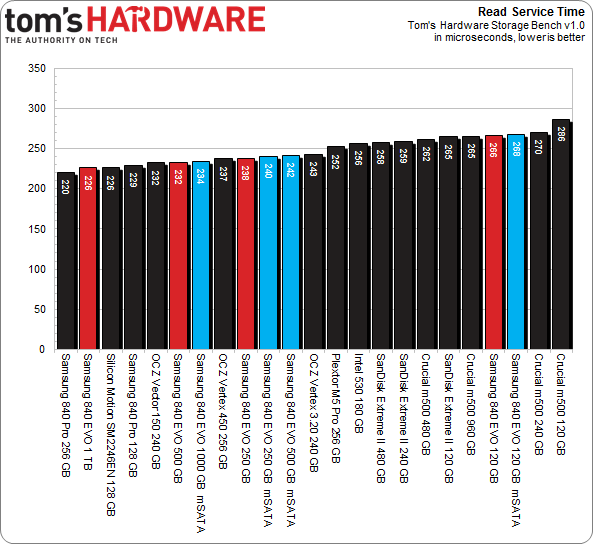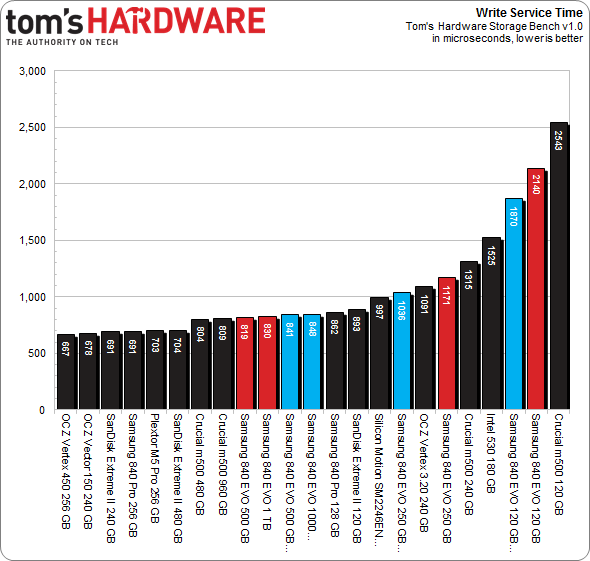Samsung 840 EVO mSATA Review: 120, 250, 500, And 1000 GB, Tested
Once upon a time, adopting mSATA-based storage meant compromising capacity and performance. With its 840 EVO, Samsung gives you access to as much as 1000 GB at incredibly fast speeds. The company even manages attractive pricing to keep mSATA competitive.
Results: Tom's Hardware Storage Bench, Continued
Service Times
Beyond the average data rate reported on the previous page, there's even more information we can collect from Tom's Hardware's Storage Bench. For instance, mean (average) service times show what responsiveness is like on an average I/O during the trace.
It would be difficult to graph the 10+ million I/Os that make up our test, so looking at the average time to service an I/O makes more sense. For a more nuanced idea of what's transpiring during the trace, we plot mean service times for reads against writes. That way, drives with better latency show up closer to the origin; lower numbers are better.
Write latency is simply the total time it takes an input or output operation to be issued by the host operating system, travel to the storage subsystem, commit to the storage device, and have the drive acknowledge the operation. Read latency is similar. The operating system asks the storage device for data stored in a certain location, the SSD reads that information, and then it's sent to the host. Modern computers are fast and SSDs are zippy, but there's still a significant amount of latency involved in a storage transaction.
Samsung's 840 EVOs fare well, regardless of interface. Once again, the 2.5" form factor is in red, while the mSATA-based models sport a fetching shade of blue.
Despite a slight increase in read latency, the 120 GB mSATA-based 840 EVO trounces the 2.5" equivalent in write latency. Both break the 120 GB M500 like a shotgun, though.
The 250 GB model demonstrates the same behavior, while the two larger mSATA-based SSDs fall just behind their 2.5" counterparts. Again, I suspect this is attributable to shoehorning 32 and 64 dies into four packages. The 2.5" 840 EVOs employ a different configuration. It's hard to identify the issue definitively, though. After all, the SATA drives are still running pre-launch firmware, while the mSATA-based SSDs employ a different version.
We can examine the results more closely by breaking out the mean read service times. As we already know, the smaller two mSATA-based 840 EVOs are close to the 2.5" implementations, while the larger two mSATA-capable models fall behind the high-capacity SATA-equipped SSDs.
Get Tom's Hardware's best news and in-depth reviews, straight to your inbox.
Mean write service times are nothing short of excellent considering how long it takes to program triple-level cell flash. As lithographies shrink, NAND becomes ever more error-prone, taking longer to erase and re-program. That factor pales in comparison to the toll imposed by cramming three bits into one cell, though. That the 840 EVOs yield lower mean service times than some high-end desktop-oriented SSDs is more than a little awesome.
Samsung's 120 GB drive isn't exactly best-of-breed. But it only uses eight dies, so that's still pretty impressive. In comparison, Crucial's 120 GB M500 fares worse, and that's with two-bit-per-cell MLC. No doubt, some of its performance deficit can be blamed on a more conservative approach to storage that employs a parity scheme, facilitating recovery should part of a NAND die fail.
Current page: Results: Tom's Hardware Storage Bench, Continued
Prev Page Results: Tom's Hardware Storage Bench Next Page Results: PCMark 7 And PCMark Vantage-
blackmagnum Maybe it's time to upgrade the HD of an old working notebook to SSD! But will a Core2Duo processor bottleneck a SSD?Reply -
jrharbort @blackmagnum: You don't have to worry about your processor being a bottleneck, but rather, your system's SATA interface. It is highly doubtful that your Core 2-based notebook (much like my own) has an m-sata slot, and the 2.5" bay for a HDD would have a SATAII port, not SATAIII. So the overall max read/write rates would be cut in half. But to answer your question in another way, tom's posted an article almost a year ago on the subject of upgrading older systems with an SSD: http://www.tomshardware.com/reviews/ssd-upgrade-sata-3gbps,3469.htmlReply -
spookyman @blackmagnum: You be glad to upgrade your hard drive to a SSD drive. Did it for my goddaughter's after she had a hard drive crash and it runs a lot faster then before.Reply -
JohnnyLucky Interesting article. It coincides with the current shift from desktop pc's to mobile pc's.Reply -
pyro226 "The latest version offers RAPID support to non-EVO drives like the 840 Pro."Got my hopes up there. The standard 840 series SSDs are NOT supported. The article didn't explicitly state they were, but what other drives (aside from the 840 Pro and EVO) have Rapid support? Perhaps "The latest version offers RAPID support to both EVO and 840 Pro SSDs." would be more accurate.Reply -
LordConrad "This company has a track record of disrupting the markets it enters; now that it's focusing attention on smaller form factors with enthusiast-class hardware, it's only a matter of time before we start seeing M.2-based offerings as well."This is mainstream hardware, I don't know any enthusiats who will settle for drives with TLC NAND.Reply -
lowguppy It is nice to see these finally available. I've been watching the Crucial m500 mSATA drive for a while, and the 480gb version frequently falls under $300 on NewEgg, which is competitive with 2.5" SSDs.Reply -
RedJaron Reply
"Enthusiast" to me doesn't automatically mean getting the fastest, biggest, bestest, craziest parts regardless of price. It also means people who put a lot more thought into their systems and thoroughly weigh all their options. MLC, TLC, or not, the fact remains that the EVO is a fast, reliable drive for a good price.12750948 said:This is mainstream hardware, I don't know any enthusiats who will settle for drives with TLC NAND.
Your argument sounds similar to, "I don't know any enthusiasts who will settle for LGA 1150 instead of LGA 2011," or "I don't know any enthusiasts that would settle for a non-K CPU."


